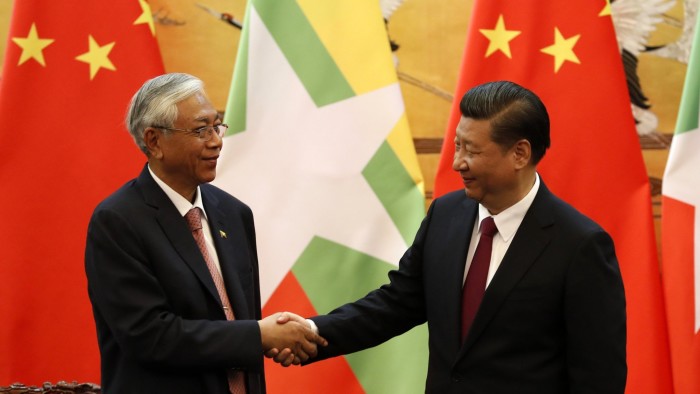China and Myanmar open long-delayed oil pipeline

Roula Khalaf, Editor of the FT, selects her favourite stories in this weekly newsletter.
China and Myanmar have finally agreed to open a cross-border pipeline into south-east China, allowing Beijing to diversify oil supply routes and reduce its dependence on the contentious South China Sea.
The agreement, announced by Chinese vice-foreign minister Liu Zhenmin at the end of a state visit by Myanmar’s president Htin Kyaw, comes as China presses its southern neighbour for access to more infrastructure deals following setbacks at other projects. Work on the controversial $1.5bn Myitsone dam project — a symbol of what some see as the excesses of Chinese influence in Myanmar — has been suspended for years.
State-owned news agency Xinhua said a ship began offloading immediately at Myanmar’s Kyaukpyu port to send crude oil up the pipeline.
The twin crude and gas pipelines on the route are key to China’s “two oceans” strategy to diversify energy supply away from the chokepoint of the Strait of Malacca and vulnerable shipping lanes through the disputed South China Sea. Once fully operational, the pipeline from Made island in Rakhine state can supply almost 6 per cent of China’s crude oil imports. The gas line is already in use.
The opening of the long-delayed crude pipeline served to mask the two countries’ inability to reach an agreement on more substantial concessions that China was trying to promote as part of its “Belt and Road” initiative, said Du Jifeng, an expert on Southeast Asia at the Chinese Academy of Social Sciences.
“China wants to use the initiative to sell more infrastructure and energy programmes overseas. But Myanmar considers there are already a lot of those type of projects in its territory and wants more investment in agriculture and light manufacturing.”
Myanmar cancelled the Myitsone dam six years ago. Chinese backers have recently shifted from demanding indemnification to pushing for preferential access to other projects as compensation. “It’s relatively less possible to resume the Myitsone Dam, so Myanmar is proposing other alternative projects to China,” Mr Du said, adding that the contractual indemnification would be “a huge burden for a small country”.
The pipeline project has been fraught with delays and opposition from citizens in both countries. It feeds a refinery in Kunming, in southwestern China’s Yunnan province, that has been the target of street demonstrations from residents opposed to its expansion.
In Myanmar, the pipeline was dogged by accusations of land grabs. Other Chinese projects, including the Myitsone dam and mines operated by Wanbao, a company controlled by the Chinese military, have raised fears in Myanmar that China’s influence over the isolated junta has enabled environmentally damaging projects that contribute little to the host country.
Both pipeline and refinery are operated by China National Petroleum Corp, or PetroChina. The state-owned oil company served as the standard-bearer for China’s “going out” strategy to secure resources overseas under now-disgraced energy and security tsar Zhou Yongkang.
But it was also motivated by CNPC’s strategy to build a refining base in south-west China, a political stronghold for Mr Zhou, and avoid the stranglehold on coastal refineries enjoyed by state-owned rival Sinopec.
Additional reporting by Archie Zhang
Twitter: @HornbyLucy
Comments